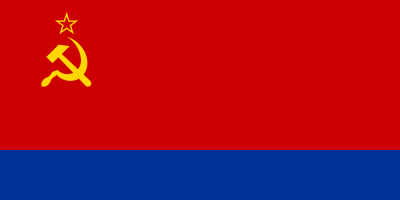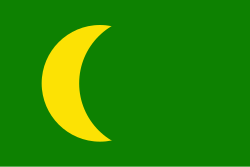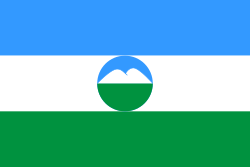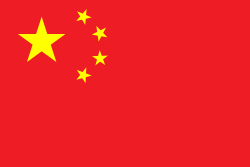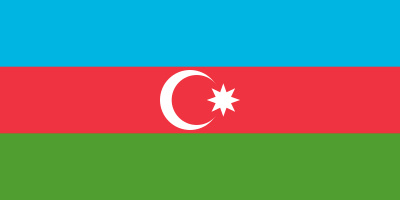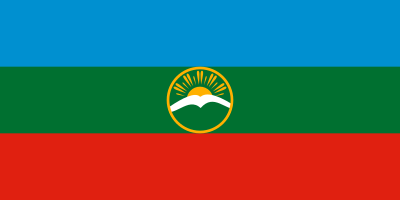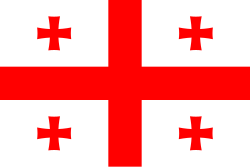Timurid
TIMURID THREE ANNULETS SYMBOL:
Three annulets symbol of the Timurids. See article [1] for precise discussion.

FROM THE CATALAN ATLAS:
In the Catalan Atlas (1375), only this flag ![]() is used for Eastern Mongol dominions, and it corresponds to the Mongol Yuan dynasty, not the Timurid Empire, which is not mentioned in the Catalan Atlas and was created too late (1370) to appear in the Catalan Atlas anyway.
is used for Eastern Mongol dominions, and it corresponds to the Mongol Yuan dynasty, not the Timurid Empire, which is not mentioned in the Catalan Atlas and was created too late (1370) to appear in the Catalan Atlas anyway.
STUDY OF THE FLAG by Yuka Kadoi, Faculty Member, University of Vienna ( (2010). "On the Timurid flag". Beiträge zur islamischen Kunst und Archäologie 2: 148.):

Yuka Kadoi studied the possibility that the "brown or originally silver flag with three circles or balls" in the Catalan Atlas could be associated with the "earlier dominions of the Timurid Empire", specifically referencing a flag shown over the city is camull (Khamil) in Xinjiang. She also quotes Ruy González de Clavijo (d. 1412), a Spanish ambassador who visited the Timurid court in 1404, who describes a a relevant emblematic design adopted by Timur:
"The special armorial bearing of Timur is the three circlets set thus to shape a triangle, which same it is said signifies that he Timur is lord of all three quarters of the world. This device Timur has ordered to be set on the coins that he has stuck, and on all buildings that he has erected (…) These three circlets which, as said, are like the letter O thrice repeated to form a triangle, further are the imprint of Timur’s seal, and again by his special order are added so as to be seen patent on all the coins stuck by those princes who are become tributary to his government."
She also notes the existence of Timur umbrella detail with three-dots decorative motif.
Some contemporary coins from Samarkand also have the three dots as a motif. [2]
Beyond this, scant confirmation.
Relevantní obrázky
Relevantní články
Bucharský chanátBucharský chanát byl sunnitský muslimský stát ve Střední Asii. Zformován byl v 16. století uzbeckou dynastií Šejbanovců, se Samarkandem jako hlavním městem, a ležel na území dnešního Uzbekistánu, Tádžikistánu, Turkmenistánu a Kazachstánu. Zemi roku 1500 dobyl chán Šejbání Muhammed, člen Zlaté hordy s kořeny mezi Volhou a Aralským jezerem, který porazil Temerlánovy nástupce. Největšího územního rozmachu stát dosáhl za vlády Abdulláha II. (1577–1598). Poté se vlády ujala dynastie Aštarchánovců (1598–1737). V roce 1740 Bucharsko dobyl íránský šáh Nádir-šáh, což lze považovat za faktický konec nezávislého státu. Ten lze klást i k roku 1747, kdy moc převzali Manghítovci, uznávající svrchovanost Osmanské říše, či k roku 1785, kdy chanát přejmenoval Ma'súm na bucharský emirát. Dalším možným koncem Bucharska je rok 1868, kdy emír Muzaffaruddín vojensky prohrál s Rusy a Bucharsko se stalo vazalem Ruské říše. V roce 1920 vládnoucího emíra svrhlo povstání a byla vyhlášena Bucharská lidová sovětská republika. .. pokračovat ve čtení
Seznam turkických dynastií a zemíZde je neúplný seznam historických dynastií, které byly v určitém čase turkické, nebo země, jejichž vládcové byly turkičtí mluvčí a současné země s významnými turkickými populacemi nebo s úředním turkickým jazykem. Turkické národy vytvořily nejméně 116 států, kaganátů, bejliků, říší, kočovních říší, sultanátů v historii až do současnosti. .. pokračovat ve čtení



















